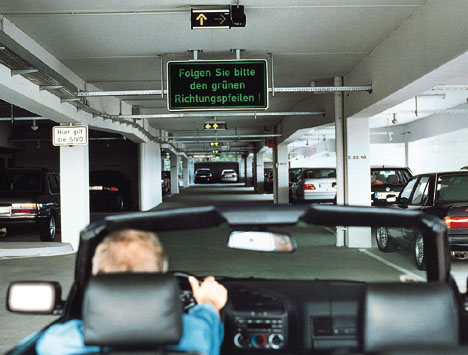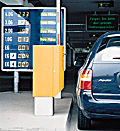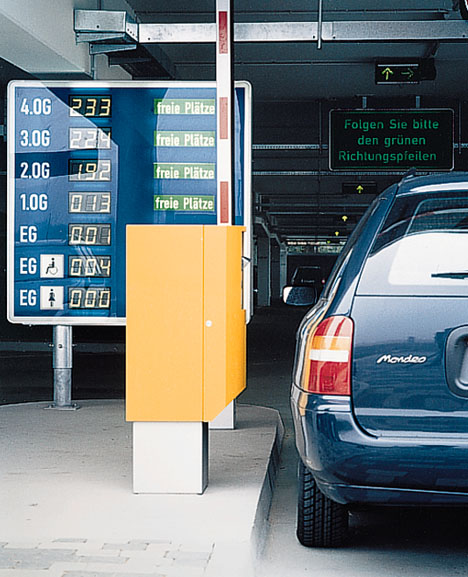 |
| The images on this page come from a Siemens web site: http://www.ad.siemens.de/news/html_76/simrepo/3_97/html_76/anw5_1.htm#start |
 |
 |
 |
 |
| This is a portion of the map that is attached to several walls of buildings in the downtown area. Unfortunately, the symbols for parking garages on the map are not visible to a driver in a car. |
| The Future of Parking in Broward County Page 6-1 Section 1 Section 2 Section 3 Section 4 Section 5 Section 6 pages 1-8 pages 9-15 pages 16-17 pages 18-20 pages 21-36 pages 37-end |
| To read the entire document on one page, CLICK HERE |
| To see photos related with each section, click on the section number. |
 |
Conclusions The future of parking in Broward County can be seen and it can be created. Presently, except for occasional peak time circumstances, there is no parking crisis in Broward County. That does not mean there are not specific problems to be solved or that some people still may think there is a crisis. It means we presently have the facilities available to deal with existing needs so long as we take steps to maximize the use of what we have. That may involve more efficient use of present spaces, better information, especially signs, about where parking is available, and, to some degree, getting people to understand that they should not expect to find a free, empty space ten steps away from their destination. Will demand increase? The future is another matter. While there are some possible changes in work and shopping behaviors which could lead to a reduced number of automobile trips and the resulting need for fewer parking spaces, they are most likely only to reduce the anticipated increase in demand, not cause an actual reduction in demand. (Key Point 9) The forecast of an increase in demand is based on increases in population, demographic changes - more young people and more active seniors -- and increasing work and non-work choices, all leading to more trips and more non-home conclusions to those trips, i.e. more parking. This means we should take steps today to make the parking experience of the future easier, less stressful and less environmentally damaging. Two poles of parking policy Parking policies fall between two poles: do nothing, let the market take its course; or aggressively restrict parking to shift people from their cars to public transportation (referred to as the San Francisco Model). San Francisco has been able to pursue this policy because it already had a very dense, very compact urban community (49 square miles), politically willing to restrict automobiles, an economic magnetism that drew countless new dot-com business to want to locate there, and an existing public transportation infrastructure of buses, trolleys, cable cars, the Bay Area Rapid Transit (BART) and a sophisticated fleet of taxis which can be hailed on the street in the downtown. Broward County, much larger geographically (414 square miles), has not achieved either the population density or the economic magnetism essential to make such a policy successful. However, Broward County is continuing to grow rapidly and a hands-off public policy will lead to chaos in heavily congested areas of the County. This report sets forth tiers of policy choices that can be adopted as policy makers determine that circumstances require. Analysis of the nine key points of the study lead to the conclusion that Broward County should begin to develop a "Smart Parking" policy that begins with creating the Parking Information Network which will lay the foundation for efficient implementation of the other parking solutions available now or in the foreseeable future. These solutions will reduce stress on drivers and on the environment and can be implemented as needed (Key Point 1). Broward County should not wait until future developments force reactive solutions (Key Point 6). Demand for parking will continue to increase but there are factors which may reduce that likely increase (Key Point 9). If parking becomes too difficult people will go elsewhere (Key Point 5). To gain acceptance of new solutions, those most likely to succeed will impose the least change on individuals (Key Point 7). People will not give up their cars until the alternatives are equally or more attractive than their present circumstances (Key Point 8). It is possible to reduce the negative impact of parking (Key Point 3). Parking facilities can and should be as attractive as any other part of our visual environment (Key Point 4). We can create the future of parking in Broward County (Key Point 2). Incremental, low-cost, short-term actions Most of the steps we have outlined are incremental, low-cost and can be implemented within a short time frame. Only a few require new and expensive technology and those do not have to be used to obtain much improved parking experiences. One first step is essential: obtaining and maintaining up-to-the-minute parking information for the entire county. This will enable public and private planners to avoid under or over building of parking facilities and allow for the fine-tuning techniques we have suggested in this report. Where parking conditions are tight or perceived to be tight, the information can then be provided to people to maximize existing parking facilities and reduce the time and stress associated with coping with these conditions. A Parking Information Network for the County would be a cost-effective first step to creating the future of parking in Broward County. Other steps could then be taken as we become aware of the need. If we begin now, we can create a future of faster, easier and cleaner parking in Broward County. ............. Key Point 1 Parking solutions are much less capital intense and have much shortest implementation times than related traffic solutions. Key Point 2 CREATE THE FUTURE OF PARKING NOW RATHER THAN WAITING FOR IT. Key Point 3 Improving access to parking, making it easier to park, increases the perception of availability of parking and reduces the stress of parking. Key Point 4 Parking facilities should be as attractive as any other part of our visual environment but they needn't be invisible. U.S. drivers like to see where their car is and is going to be. Key Point 5 If the experience of parking is too stressful, expensive or difficult, people won't park there and they will go somewhere else. Key Point 6 Doing nothing is a choice just as much as adopting one or more policy choices. Doing nothing actually means choosing to have a wide variety of public and private decision makers respond on an ad hoc basis to each need or "crisis" as it arises. If the response is inadequate, people will adjust various ways and life will go on. Key Point 7 Until the crunch is severe, those solutions will work best which require the least change of behavior by consumers. Key Point 8 Most traffic-policy reduction programs involve getting people out of their cars more - that will not happen in South Florida until we "dress light." Key Point 9 Changes in work and shopping behaviors are most likely only to reduce the anticipated increase in demand, not cause an actual reduction in demand. Background Materials For readers who want more of the details. The study was designed to be read in one sitting. It is supported by visuals that help the reader to grasp the complexity and interconnections of the subject. Parking is not just about placing cars in safe, convenient zones in a downtown area. Parking defines the interactions between people and the environment and colors their experience of the city. The best way of capturing the concepts visualized in this report would be with an animated documentary, which is recommended for a future information campaign about parking policy issues that might one day be directed at the general public. The audio-visual items that support this study as background materials include several videos that have been converted to run on Quicktime Software. Videos on CD: Robotic Parking (Information) Robotic Parking (TV broadcast) Visit to Publix Multi-Story Garage in Miami Beach The Case Study: Las Olas Art Fair (September 2001) Auto-Park Demonstration Contacts Paul Carpenter, Executive Director, Downtown Fort Lauderdale Transportation Management Authority. 761 3543 Ridership runs an average of 300,000 a year. The "park and ride" lot at 441 and Oakland Park Blvd. has about 57 riders a day. The ridership in the morning tends to be higher than the number of riders in the afternoon (some morning commuters apparently catch a ride home on the bus or with a friend). Two shuttle buses both make two trips in both the morning and the evening, a total of 8 round trips per day. Ed Davis, County Parking Manager A fifteen-foot tall sign (viewable from Broward Blvd. along SW 1st Avenue from Broward), will be installed on the County Garage. This is the first of what this study's writers hope will be more signage to help the first-time visitor to Broward County in navigating. The diagram is a schematic: it does not represent the actual end product and it is an artist's rendition. It was provided by the very helpful and consumer-oriented parking manager who works for the County. Source: Ed Davis, [email protected] TRANSPORTATION PLANNING DIVISION 357-6608 115 S. Andrews Avenue, Room 329H, Ft. Lauderdale, 33301 FAX 357-6228 Director: Bruce Wilson 357-6641; Congestion Management Team - Enrique R. Zelaya 357-6635; Long Range Transportation Planning Team - Ossama Al Aschkar, P.E. 357-6653 Jeff Weidner, Florida Department of Transportation Jeff coordinated a useful series of workshops to bring together teams that are working on various projects in Broward and Southeast Florida. His workshops helped many participants realize that each team is not only working on a specific project, but also helping to construct part of a transportation system for the region. Publications Countywide Parking Policy Study for Miami-Dade County (project No. E95-MPO-02R), August 1999, prepared by Barton-Aschman Associates. Provided by Jesus Guerra, [email protected], 111 NW First St, Miami, FL 33128, (305) 375-4507 Year 2000 Traffic Count Report, April 2001, Broward County Metropolitan Planning Organization. Parking Study - Beach Area (2000) Walker Parking Consultants (made available to us through the courtesy of Doug Gottshall, City of Fort Lauderdale). This 45-page study includes data from surveys in August and September 2000. In a related matter, the City of Fort Lauderdale paid for a detailed transportation study including parking issues which is expected to be completed in 2002. Copies should be available from the City of Fort Lauderdale at that time. Collection of Parking Ordinances: A complete set of parking ordinances for Broward County and its municipalities can be accessed by sending an e-mail message to Rosalia Bunge ([email protected]) at Broward County's Department of Planning and Environmental Protection (DPEP). The Parking Professional (industry monthly magazine), International Parking Institute, Fredericksburg, Va. Benchmarking the Parking Profession, 2001. International Parking Institute, Fredericksburg, Va. Web site references Intelligent Parking Garages, by B. Ran and S. Leight WEB: www.cae.wisc.edu/~uwits/programs/garages.html Siemens Intelligent Traffic Systems WEB: http://www.atd.siemens.de/traffic/siemens_english/ebene0/index.htm Siemens: Parking in no time at all. (Interactive system with signals to the driver). http://www.ad.siemens.de/news/html_76/simrepo/3_97/html_76/anw5_2.htm County Parking Facility License A parking facility license is required of any facility that exceeds fifteen parking spaces for a single-level parking lot or 750 parking spaces for a parking garage. WEB: www.broward.org/aqi02300.htm Alan Durning, June 26, 2001, "Cheap parking spaces drive up fuel prices" (opinion) Web archive of the www.Seattletimes.com The citizen's group that opposed a parking garage on Deerfield Beach. WEB: www.saveourbeach.com Congestion in Broward County (photos) WEB: http://www.geocities.com/creatingthefuture/parkingcongestion.html Parking can help attract and support redevelopment. WEB: http://www.ci.fairfax.va.us/City/ReDevelopmentCOF.htm "...the city will invest approximately $30 million in public improvements to North Street, constructing parking garages and undergrounding utilities in the Old Town area." The inventory of parking spaces in 17 major garages in downtown Fort Lauderdale are located at www.geocities.com/futureofparking/pin.html. Products and Concepts Sidewalk Sails(tm) by JK McCrea. Protected sidewalks tend to encourage pedestrian traffic. Protection from rain and sun should encourage people to walk farther from their cars. The graphic on page 36 is called Sidewalk Sail and it is copyrighted in 2001 by JK McCrea [email protected]. The conceptual drawings appear in this study with the permission of its creator. www.geocities.com/americanarchitecturalsigns/sail.html |